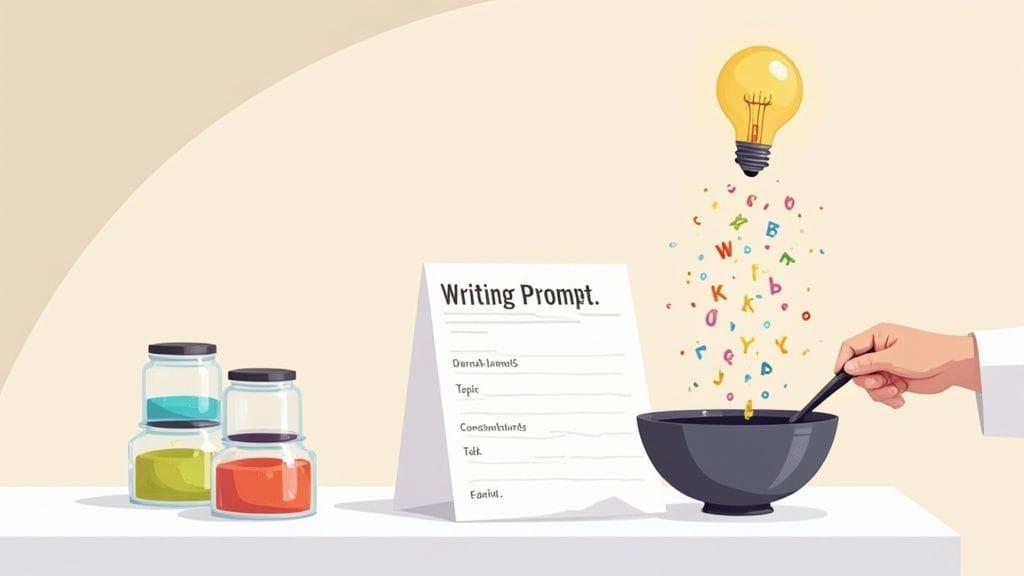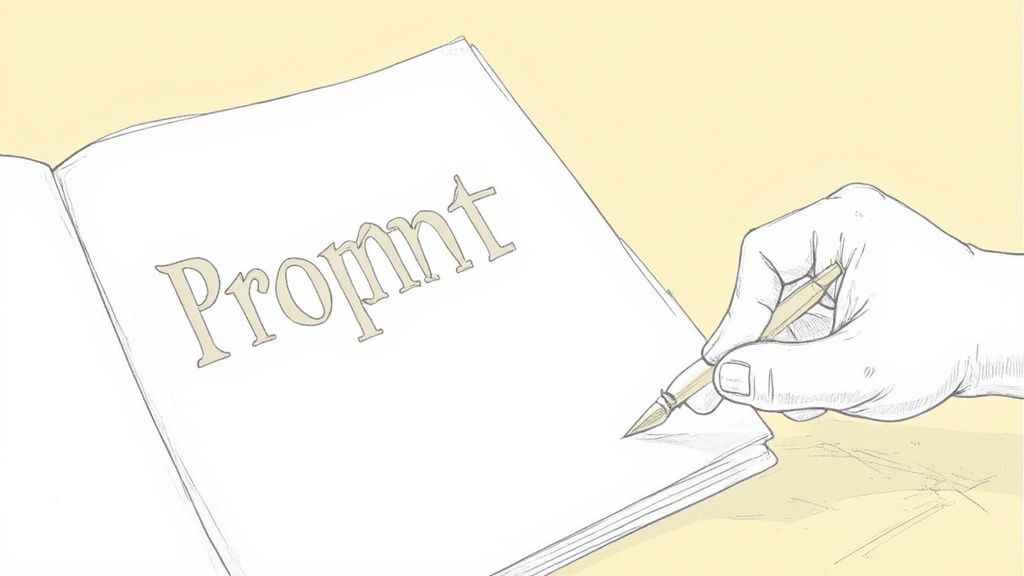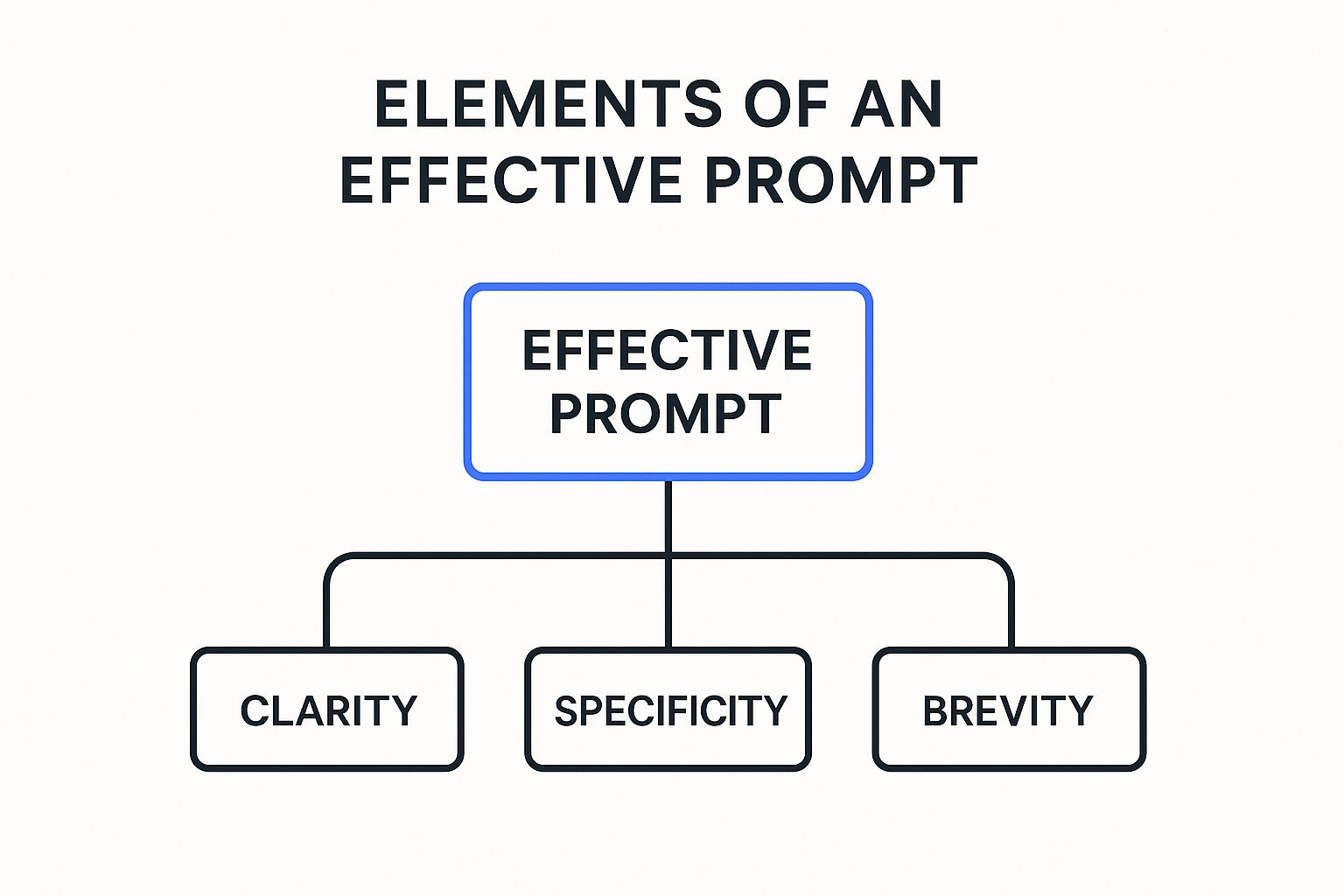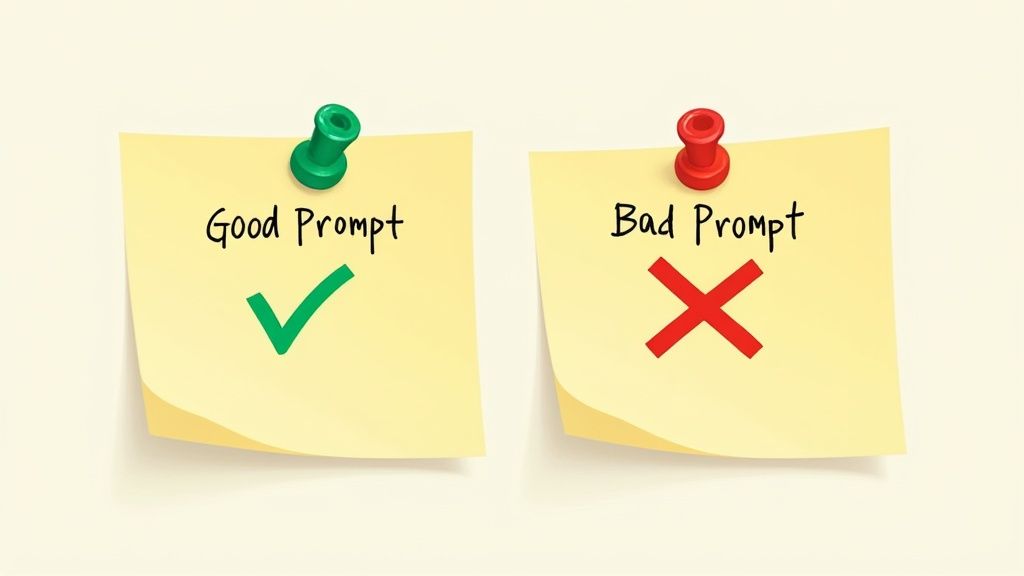Definition of Prompt in Writing: Clear Explanation for Beginners

At its most basic, a writing prompt is simply a starting point—a set of instructions meant to kickstart a specific piece of writing. Think of it as a launchpad for your ideas. It takes a massive, vague topic and gives you a clear direction and a specific mission before you ever type a single word.
What Exactly Is a Writing Prompt?

Let's dig a little deeper than a simple dictionary definition. A writing prompt isn’t just a question; it's more like a recipe for a piece of writing. A good recipe gives a chef the ingredients, measurements, and method. In the same way, a good prompt gives a writer all the essential components needed to create something effective.
This simple tool is a powerful catalyst for just about anyone. It helps students structure an essay, and it helps professional writers bust through a nasty case of writer's block. It turns that intimidating blank page from a source of anxiety into a space with clear goals and boundaries.
The Three Core Components of a Writing Prompt
At its heart, every effective prompt is built from a few key ingredients that work together to guide your writing. When you learn to spot these parts, you can break down any prompt and deliver exactly what's needed.
Here’s a simple table that breaks down the three core components.
| Component | What It Does | Simple Example |
|---|---|---|
| The Subject | This is the what—the core topic or idea you need to write about. | "The American Revolution" |
| The Task | This is the how—the specific action verb telling you what to do. | "Compare and contrast the causes..." |
| Constraints | These are the rules—any limitations like word count, tone, or format. | "...in 500 words or less." |
Putting it all together, you get a clear, focused instruction that leaves little room for confusion.
By mastering how to read these elements, you start to see prompts not as rigid rules, but as helpful frameworks.
A great prompt doesn't just ask a question; it provides a framework. It gives you the freedom to be creative within a defined space, ensuring your final piece is both original and on-point.
When you understand the architecture of a prompt, you can build a response that is focused, effective, and perfectly aligned with the original goal. It’s the difference between wandering aimlessly and writing with true purpose.
Tracing the History of Writing Prompts

Writing prompts might feel like a modern classroom staple, but their history goes back thousands of years. They aren't a new invention; they're a tried-and-true educational tool that has stood the test of time. While the methods have evolved, the core idea—a stimulus to guide a writer's thoughts—has stayed remarkably consistent.
This tradition really starts in ancient Greece with rhetorical exercises called progymnasmata. These weren't just simple questions. They were carefully structured tasks meant to teach students the fundamentals of persuasive writing and public speaking. Students would be asked to do things like paraphrase fables, describe a scene with vivid detail, or build up an argument. You can dive deeper into these classical methods in this detailed overview from the University of Iowa.
The whole point was to build skills incrementally. Think of it like a coach using specific drills to train an athlete—it’s all about mastering the basics before moving on to the big game.
From Medieval Tales to Modern Classrooms
This educational approach didn't just disappear after the Greeks. In medieval times, prompts often came in the form of storytelling challenges. A scribe or storyteller might be tasked with retelling or expanding on a popular legend or a moral fable, working within established themes and narrative arcs.
Fast forward to the 20th century, and prompts became a cornerstone of both creative movements and formal education. They proved incredibly useful for a few key reasons:
- Unlocking creativity: They helped writers sidestep the fear of the blank page and explore fresh ideas.
- Standardizing assessment: In schools, they offered a consistent and fair way to evaluate a student's writing ability.
- Developing critical thought: Prompts pushed students beyond simple narration, asking them to analyze, persuade, and reflect on complex topics.
The prompt has always been a conversation starter between the instructor and the writer. It sets the stage, defines the challenge, and invites the writer to demonstrate their unique voice and perspective within a given framework.
Today, this ancient tool is more relevant than ever. It’s the foundation for everything from standardized college entrance exams to the instructions we feed to powerful AI models like ChatGPT. This long history proves that prompts are a deeply effective way to cultivate focused, powerful writing.
Exploring the Main Types of Writing Prompts
So, you've got the basic idea of what a writing prompt is. Great. The next thing to realize is that not all prompts are created equal. Think of them like a carpenter's tools—you wouldn't use a sledgehammer to drive a finishing nail. Different prompts are designed for completely different jobs, and knowing which one you're holding is the first step to getting the work done right.
Writing prompts today fall into a few key categories, each designed to get a specific kind of response from you. The most common are descriptive, narrative, expository, and persuasive prompts. A descriptive prompt, for example, might ask you to "describe the best party you have ever attended," pushing you to focus on sensory details. On the other hand, a research prompt requires you to dig up information and stitch it together. You can find more classic essay prompt examples over at Study.com.
Grasping these categories helps you zero in on what the prompt is really asking you to do.
This visual breaks down the key ingredients that make any prompt, regardless of its type, truly effective.

As you can see, clarity, specificity, and brevity are the bedrock of a good prompt. They ensure you know exactly what’s expected of you, leaving no room for guesswork.
Common Prompt Categories Explained
Let's dig into the 4 main types of prompts you'll run into most often. Each one demands a unique writing style and a different way of thinking. Once you can spot them, you're already halfway to a great response.
- Descriptive Prompts: These prompts are all about painting a picture with words. Your job is to pull the reader into a moment using sensory details—what did it look, sound, smell, taste, and feel like? An example would be, "Describe a place where you feel completely at peace."
- Narrative Prompts: Ready to tell a story? Narrative prompts give you the stage. They usually have the classic story elements: characters, a setting, a plot, and some kind of conflict. A classic example is, "Write about a time you faced a major challenge and what you learned from it."
My best tip? Always look for the core verb in the prompt. Is it asking you to describe, tell a story, explain, or convince? That one word is your biggest clue to what you need to do.
- Expository Prompts: Think of these as the "just the facts" prompts. They ask you to explain or inform the reader about a topic in a clear, objective way. You'll need to back up your points with facts, stats, and solid examples. A typical expository prompt is, "Explain the main causes of the Industrial Revolution."
- Persuasive Prompts: With these, your mission is to take a stand and convince the reader to see things your way. You'll need a strong thesis statement, killer evidence, and a really compelling argument. For instance, "Argue for or against the implementation of a four-day workweek."
A Quick Guide to Writing Prompt Types
Here's a simple table to keep these types straight. Use this as a quick reference to understand the purpose and common applications for different kinds of prompts.
| Prompt Type | Primary Goal | Commonly Used For |
|---|---|---|
| Descriptive | Create a vivid, sensory experience | Creative writing, journaling, character sketches |
| Narrative | Tell a story with a clear plot | Personal essays, short stories, memoirs |
| Expository | Inform or explain a topic clearly | Research papers, how-to guides, technical writing |
| Persuasive | Convince the reader of a viewpoint | Opinion pieces, debate prep, marketing copy |
Knowing these differences helps you immediately shift your tone, structure, and approach to fit what's being asked.
If you're ready to move past the basics, our guide on the different types of prompting explores more advanced categories and how to use them. This knowledge is what separates a generic response from one that truly hits the mark.
How Prompts Build Stronger Writing Skills
Writing prompts are much more than simple assignments; they're training grounds for writers. Think of them as a controlled environment where you can zero in on specific skills without the extra pressure of coming up with a topic from scratch.
It’s a bit like a musician practicing scales before attempting a complex sonata. The prompt gives you the structure, so you can focus entirely on your technique—your word choice, sentence flow, and the strength of your argument.
This kind of focused practice builds what we call writing fluency, which is just a fancy way of saying you can get your thoughts down clearly and efficiently. Prompts act as scaffolding, helping you build confidence and the stamina to write longer, more thoughtful pieces. They gently push you out of your comfort zone, sharpening your critical thinking and helping you articulate ideas with more depth.
Measuring Growth and Stamina
One of the best things about using prompts regularly is that you can actually see your progress. When you tackle similar types of prompts over and over, the improvements in both the quality and quantity of your writing become obvious.
Prompts are not just starting lines; they are benchmarks. They create a consistent way to measure how a writer's analytical skills, clarity, and overall endurance improve over time.
For example, a study involving 10th-grade students found that consistent practice with historical writing prompts made a huge difference. At the start of the year, their essays averaged just 182 words. By the end, that figure had jumped by 57% to an average of 322 words. You can dig into the full study over at HistoryRewriter.com.
This shows that prompts don't just spark ideas—they actively build the mental muscle needed for more substantial writing. If you're interested in applying this idea to newer technologies, our guide on mastering AI storytelling with system prompts explores some advanced techniques.
Ultimately, this skill development lays a foundation for stronger communication, preparing you for any writing challenge you might face, whether in school or in your career.
A Practical Guide to Analyzing Any Prompt

It’s one thing to know what a prompt is, but it’s another thing entirely to know how to break one down. This is the skill that truly separates good writers from great ones. Instead of just diving in and hoping for the best, a deliberate analysis ensures your writing is sharp, relevant, and exactly what was asked for.
Think of yourself as a detective arriving at a crime scene. The prompt is your set of clues. Your job is to meticulously identify the core components—the subject, the task, and any constraints—before you start forming a conclusion. This simple habit helps you sidestep the most common mistake in writing: creating a brilliant piece that completely misses the point.
Deconstructing a Prompt Step by Step
Let’s get our hands dirty and dissect a real-world example together.
Imagine you're given this prompt: "Compare and contrast the immediate effects of social media on community engagement versus its long-term impacts, in 800-1000 words."
Here’s how to break it down.
- Identify the Core Task: Look for the action words. They’re your biggest tell. Here, the task is to "compare and contrast." This isn't just a simple request to describe the effects; you need to actively weigh their similarities and differences. If the prompt had said "analyze," "argue," or "summarize," your entire approach would need to change.
- Pinpoint the Subject: What, exactly, are you writing about? It’s not just "social media." The true subject is "the immediate effects of social media on community engagement" versus "its long-term impacts." That dual focus is the absolute heart of the prompt.
- Recognize All Constraints: These are the rules of the road. The most obvious one is the word count: 800-1000 words. But there's a less obvious constraint, too—the scope. You are required to address both immediate and long-term impacts. Leaving one out means you’ve only answered half the question.
A prompt isn't a suggestion; it's a blueprint. Every word is chosen for a reason. Learning to read that blueprint guarantees you'll build exactly what was asked for, every single time.
This analytical approach strips away the guesswork. It gives you a solid plan before you even think about writing that first sentence.
This level of precision is even more critical when you're working with AI tools. You can learn more about applying these same principles in our guide to mastering ChatGPT for crafting effective writing prompts to get much better results.
Got Questions About Writing Prompts? Let's Clear Things Up.
Even after you get the basic idea, a few questions always seem to pop up. It's one thing to know what a prompt is, but it's another to understand how they actually work out in the wild.
Let's dive into some of the most common points of confusion and get you some straight answers. We'll sort out the differences between similar terms and see how prompts show up everywhere, from your high school English class to the latest AI tools.
Prompt vs. Topic: What's the Real Difference?
It’s easy to use these words interchangeably, but they’re not the same thing at all. Think of a topic as a general subject, like "climate change" or "the Roman Empire." It's a big, open field with no specific directions.
A prompt, on the other hand, is your specific mission within that field. It gives you a task, a focus, and usually a few ground rules.
A topic points you to a city. A prompt gives you the street address, the time to be there, and what to bring. It turns a vague idea into a concrete assignment.
For instance, "leadership" is a topic. But "Analyze Abraham Lincoln's leadership style during the Civil War in 500 words"—that's a prompt. It provides the specific instructions that the topic alone is missing.
Are Prompts Just for Creative Writing?
Not even close. While prompts are fantastic for kickstarting a short story or a poem, that’s just one small piece of the puzzle. They are fundamental tools in just about any field where you need to write something with a clear purpose.
You'll run into them constantly in:
- Academic writing for essays and research papers.
- Business proposals and market analysis reports.
- Standardized tests like the SAT or GRE, where they're used to gauge critical thinking.
- AI content tools, which rely on prompts to generate specific text.
How Are AI Prompts Different from Prompts for Humans?
The basic idea is the same—give clear instructions—but prompts for AI demand a whole other level of detail. A human writer can pick up on subtle cues. They can infer context, guess at the tone you want, and read between the lines. An AI can't do any of that; it only knows exactly what you tell it.
For a person, you could probably get away with, "Write a sad story about a robot." But to get a good result from an AI, you'd need something more like: "Write a 500-word short story in the melancholic style of Kazuo Ishiguro about a sanitation bot who discovers an old photograph and longs for a past it never had."
With AI, you have to spell out the tone, style, length, and context that a human writer would naturally fill in.
Ready to build, organize, and perfect your own set of powerful prompts? At Promptaa, we give you the tools to create and manage a personal prompt library for any project you can imagine. Get started today and see just how much of a difference the right instructions can make. Find out more at https://promptaa.com.